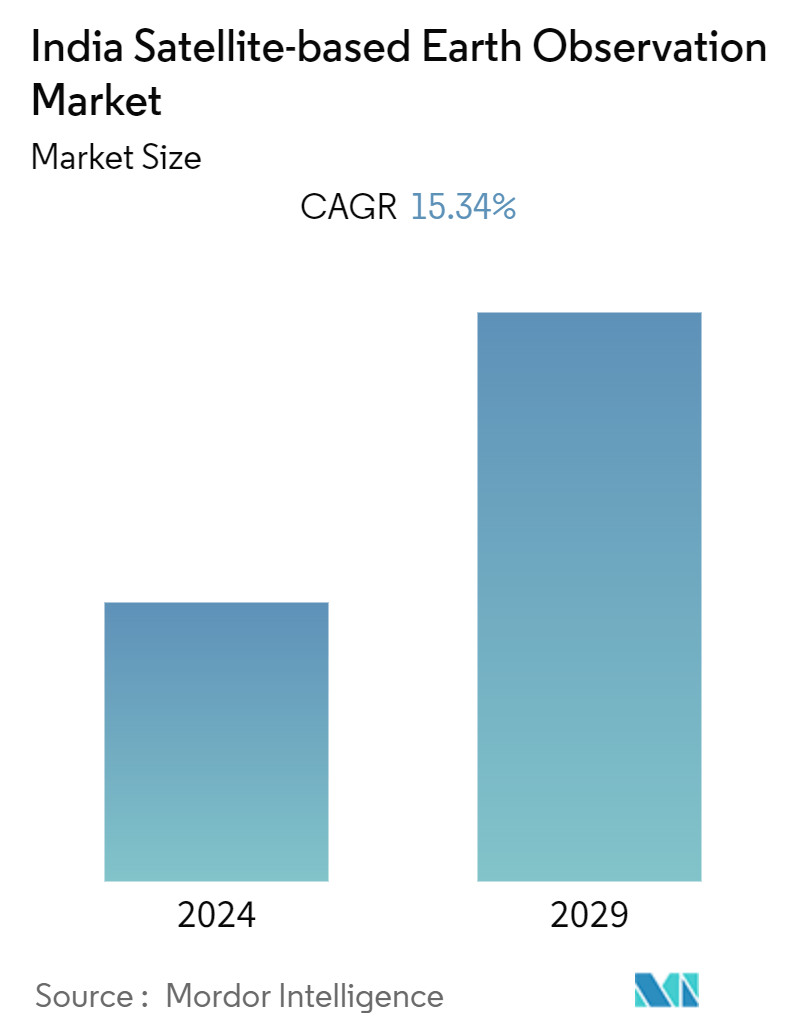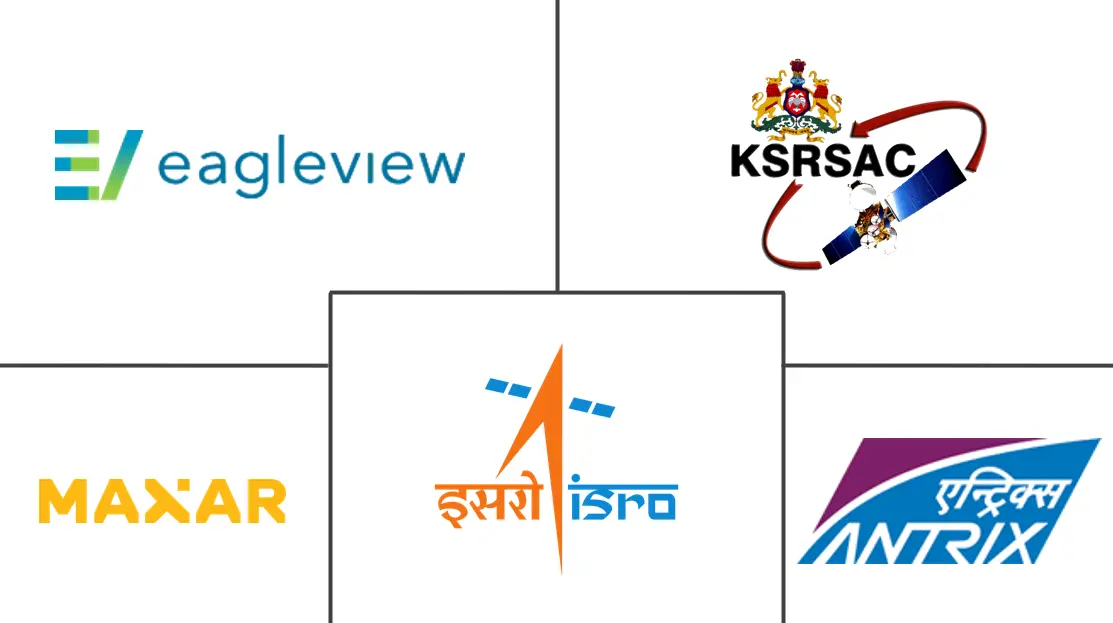Market Size of India Satellite-based Earth Observation Industry

| Study Period | 2019 - 2029 |
| Base Year For Estimation | 2023 |
| Forecast Data Period | 2024 - 2029 |
| Historical Data Period | 2019 - 2022 |
| CAGR (2024 - 2029) | 15.34 % |
| Market Concentration | Low |
Major Players
*Disclaimer: Major Players sorted in no particular order |
India Satellite-based Earth Observation Market Analysis
The India Satellite-based Earth Observation Market is expected to register a CAGR of 15.34% during the forecast period.
There is a growing demand for accurate and timely geospatial information across various sectors such as agriculture, urban planning, infrastructure development, environmental monitoring, disaster management, and defense. Satellite-based earth observation provides a valuable source of geospatial data, driving the market as the need for such information expands.
- India has made significant strides in satellite-based earth observation, primarily driven by the Indian Space Research Organisation (ISRO), the country's prominent space agency. ISRO has successfully launched several remote sensing satellites, including the Resourcesat, Cartosat, and Oceansat series, equipped with advanced imaging and sensing capabilities.
- The market is driven by various factors, including the increasing demand for accurate geospatial information, the government's initiatives and investments, technological advancements in satellite technology and data processing techniques, the need for improved agricultural practices and food security, urban development and infrastructure planning, disaster management and climate change monitoring, defense and security applications, and the emergence of commercial opportunities.
- The government of India has been actively supporting satellite-based earth observation through programs like the National Remote Sensing Centre (NRSC) and the National Geospatial Program (NGP). These initiatives aim to enhance the country's earth observation capabilities, promote research and development, and facilitate the dissemination of satellite data and geospatial information to various user sectors.
- Further, advancements in satellite technology, remote sensing instruments, and data processing techniques have significantly improved the capabilities of satellite-based earth observation. Higher-resolution imagery, improved spectral capabilities, and enhanced data processing algorithms enable more detailed and accurate Earth surface analysis. Technological advancements continue to drive market growth by providing better data quality, higher efficiency, and improved analysis capabilities.
- Despite significant advancements, satellite-based earth observation still has certain limitations. These include limitations in cloud cover, temporal resolution, revisit frequency, and accuracy of specific parameters. Overcoming technical limitations and continuously improving data quality and processing capabilities are necessary for expanding the market's potential.
India Satellite-based Earth Observation Industry Segmentation
Satellite-based earth observation is done with the help of satellites orbiting around the planet to view and identify environmental changes, map making, etc. Satellite-based earth observation technology captures and stores information from satellites relating to the physical, biological, and chemical compositions of the earth for monitoring, surveillance, and decision-making in various verticals, such as defense and intelligence, infrastructure and engineering, natural resource management, energy and power, and disaster management.
The India satellite-based earth observation market is segmented by type (earth observation data, value-added services), satellite orbit (low earth orbit, medium earth orbit, geostationary orbit), and end-use (urban development and cultural heritage, agriculture, climate services, energy and raw materials, infrastructure, and other end-use).
The market sizes and forecasts are provided in terms of value (USD) for all the above segments.
| By Type | |
| Earth Observation Data | |
| Value Added Services |
| By Satellite Orbit | |
| Low Earth Orbit | |
| Medium Earth Orbit | |
| Geostationary Orbit |
| By End-Use | |
| Urban Development and Cultural Heritage | |
| Agriculture | |
| Climate Services | |
| Energy and Raw Materials | |
| Infrastructure | |
| Other End-Use |
India Satellite-based Earth Observation Market Size Summary
The India satellite-based earth observation market is poised for significant growth, driven by the increasing demand for precise and timely geospatial information across various sectors such as agriculture, urban planning, infrastructure development, environmental monitoring, disaster management, and defense. The Indian Space Research Organisation (ISRO) has been instrumental in this growth, launching advanced remote sensing satellites like the Resourcesat, Cartosat, and Oceansat series. These satellites provide critical data that supports government initiatives and investments aimed at enhancing earth observation capabilities. The market is further bolstered by technological advancements in satellite technology and data processing techniques, which offer improved data quality and analysis capabilities. Despite these advancements, challenges such as cloud cover, temporal resolution, and accuracy of specific parameters remain, necessitating ongoing improvements in data quality and processing capabilities.
The Indian government's proactive role in promoting satellite-based earth observation is evident through various programs and policies, such as the National Remote Sensing Centre and the Indian Earth Observation Satellite policy. These initiatives aim to enhance the country's earth observation capabilities and facilitate the use of satellite data across multiple sectors. The agriculture sector, in particular, benefits significantly from satellite-based earth observation technologies, which provide valuable insights for monitoring crop health, optimizing resource management, and improving agricultural productivity. Government support, along with initiatives like the National Agricultural Drought Assessment and Monitoring System, further drives the adoption of these technologies in agriculture. The market is characterized by a diverse range of public and private players, including ISRO, Antrix Corporation Limited, and Maxar Technologies Holdings Inc., contributing to the development and application of satellite imagery and data analytics for earth observation purposes.
India Satellite-based Earth Observation Market Size - Table of Contents
-
1. MARKET INSIGHTS
-
1.1 Market Overview
-
1.2 Industry Attractiveness - Porter's Five Forces Analysis
-
1.2.1 Bargaining Power of Buyers
-
1.2.2 Bargaining Power of Suppliers
-
1.2.3 Threat of New Entrants
-
1.2.4 Threat of Substitutes
-
1.2.5 Intensity of Competitive Rivalry
-
-
1.3 Industry Value Chain Analysis
-
1.4 Assessment of the Impact of COVID-19 on the Market
-
-
2. MARKET SEGMENTATION
-
2.1 By Type
-
2.1.1 Earth Observation Data
-
2.1.2 Value Added Services
-
-
2.2 By Satellite Orbit
-
2.2.1 Low Earth Orbit
-
2.2.2 Medium Earth Orbit
-
2.2.3 Geostationary Orbit
-
-
2.3 By End-Use
-
2.3.1 Urban Development and Cultural Heritage
-
2.3.2 Agriculture
-
2.3.3 Climate Services
-
2.3.4 Energy and Raw Materials
-
2.3.5 Infrastructure
-
2.3.6 Other End-Use
-
-
India Satellite-based Earth Observation Market Size FAQs
What is the current India Satellite-based Earth Observation Market size?
The India Satellite-based Earth Observation Market is projected to register a CAGR of 15.34% during the forecast period (2024-2029)
Who are the key players in India Satellite-based Earth Observation Market?
Indian Space Research Organisation (ISRO), Antrix Corporation Limited, Maxar Technologies Holdings Inc., EagleView Technologies, Inc. and Karnataka State Remote Sensing Applications Centre (KSRSAC) are the major companies operating in the India Satellite-based Earth Observation Market.

